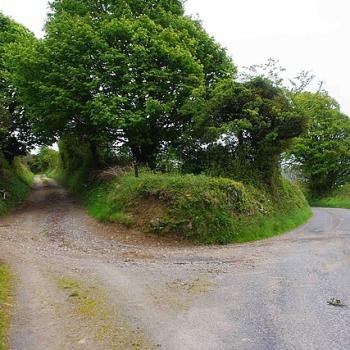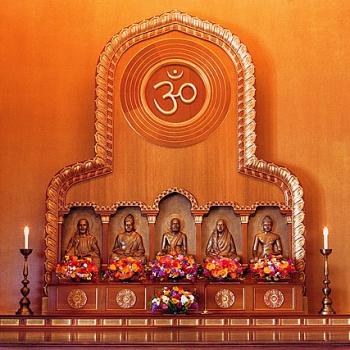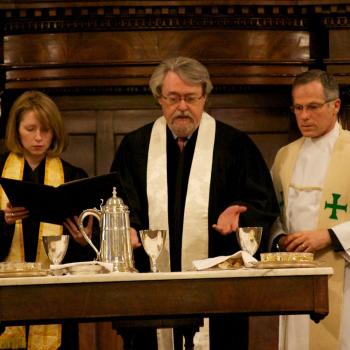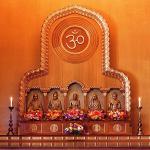MAGIC LANDS
Zen, Makyo, and the Loosening of the Bonds of Perception
James Ishmael Ford
As we embark on the spiritual path what we may have spent a lifetime thinking was real and concrete, rather quickly reveals it is not. Sometimes these disruptions of the old and intimations of something new are graces, disruptions of the world opening us into the mystery. More often these are something a bit different. I
n Zen the term for these experiences that are less than awakening, is makyo.
The Zen teacher Dosho Port explains the first of the two characters for makyo can mean demon or magic, while the second can be read as a place or boundary or condition. The colloquial rendition I’ve most heard for makyo is “demonic interference.” I’ve also heard it called the “demon cave” and sometimes “ghost cave.” Perhaps you feel the sense of cave in all its negative uses. Dark, dank, dangerous. I guess a literal rendition of makyo into English would be “demon land.” Although as Dosho Port notes, while on occasion it is “demon land,” often, maybe most often the best term would be “magic land.”
So, entering the magic lands.
Mostly these are small disruptions, physical or perceptual distortions. Dosho Roshi describes how early in his practice the sensation of his hands seeming to grow larger and seeing faces on blank walls. I’ve seen those faces, myself. As well as other things when facing a wall for zazen, and when gazing downward at the floor. Early on the strangest of my persisting physical makyo was listing strongly to one side while feeling I was sitting upright. The monitor would correct my posture, gently pushing me back upright, and I would feel sure I was being pushed to an angle.
Zen invites intensive practice. And I endorse this. Especially for a period of one’s life, where the discipline might take over all other aspects of one’s life. The spiritual life is a matter of life and death, and it deserves our full attention. And to really dig in and establish a deep practice can inform one for the whole of one’s life.
However, this time is not without its dangers. The neuroscientist and old Zen hand James Austin notes how especially within “intensive meditative concentration for weeks or months invariably yields visual or auditory aberrations, hallucinations, or unusual somatic experiences.” Those sensations of growing hands, the projection of faces and actions, our bodies no longer sure of up and down.
And there’s more than physical distortions. Our sense of balance, our sense of the real is challenged in the depths of our practice. And being unaware that this will happen can trigger a lot of problems. If one has significant mental health issues, the side effects of sustained practice can be an extended encounter with those old issues. Today in Western Zen centers applications to retreats often include questions about mental health. And people are, and certainly should be, cautioned about these dangers. Dangers that are most evident during intensive retreat.
My interest these days is more with the general arc of the spiritual life whether one is engaged in that period of intensive training or simply engaged in a sustained and regular spiritual practice within a householder life. I’m especially interested in people raising children or caring for others, or who simply cannot afford the time away from gainful employment, and what those lives look like. But, who are committed to the matter of the heart, of understanding who we are, and what might in fact be the depths of our lives where we find ourselves. As we find ourselves.
If we’re on the path in a monastery or working in a bookstore, if we are giving it the attention it deserves, our lives begin to fracture, the certainties begin to dissolve.
So, simple distortions of our physical orientation, our seeing things in the patterns of paint, they happen. And. Makyo can take on much larger contours as well. It is not uncommon to have full blown visions. These can be at the edge of consciousness, similar to a waking dream where one can experience it while being aware it is a mental state. Aitken Roshi’s famous story of being in an ancient temple with monks circumambulating while chanting. And they can completely take over for a time, fully into the dream.
And these are not limited to our time in meditation.
I had a major such visionary experience. It happened during a Zen meditation retreat. Sitting I had a vision of Jesus walking toward me, his hands, palm to palm together like the Christian prayer mudra, Hindu namaste, or Zen’s gassho, and saying, “I have a great gift for you.”
My immediate thought was of my childhood Jesus, the one with all the little children. And I felt waves of love washing over me. Then. He spreads his hands to reveal those infamous bleeding wounds. A terrible visceral fear leapt into my throat, as he then grasped my own hands with those bleeding hands. And, with that the pain of worlds birthing and dying ran from his wounds into what are now mine. And it was over. I was back in the meditation hall. My hands hurt for weeks. Actually, to this day I can still touch an echo of that hurt.
While there is nothing that happens in the monastery that doesn’t also happen in ordinary life, outside of the cloister it’s very easy to turn or be turned away from the fundamental matter. Distraction is a lot easier in our “regular” lives. But to underscore: everything available to the renunciant, for life or for a period of time, is in fact available to anyone who turns their heart toward the mystery and invite the intimate way into their lives. Including makyo. Including having chanting monks circumambulate around you, including being visited by Jesus. Or Buddha. Or. Your mind, your heart will paint a specific picture just for you.
So, what to do?
In the Surangama Sutra, chapter ten speaks to “demonic” states of mind. Where once one has learned the practices, and are engaging them, if one is not wary, if one does not find the deeper perspectives, you may not recognize what’s happening. And if you don’t danger awaits. Altered states, visions, sensations of perspective, noticing oneself from above or outside of oneself, experiences that resemble paranormal accounts. Visits from Jesus. Whatever they are. The best way to meet them is simple enough.
Zen teacher 101, “Don’t worry. This will be pass.”
This will pass. This, too, will pass. The touchstone of practice of the spiritual way when encountering states, any state, beautiful or ugly; is recollecting that all things pass. Including, always including, this state. There is no need to judge the state as demonic or magic. Just notice it. Just remember it isn’t permanent.
Grasping the state, whatever the state is, holding it as important, well, quickly magic can transform into demon. For me, it was very important to let the vision of Jesus and my hurting hands to play out. It doesn’t mean it wasn’t important. The substance of such things comes along later. Mostly things dissolve into memory. Sometimes it is the beginning of greater unfolding. But to assume anything other than this too will pass is a mistake.
In the Surangama there are fifty of these states. I think there are vastly more than that. These states are limited only by the limitations of our own specific personal conditioned existence. Limited only by our bodies and our emergent minds. These are the visitations of aspects of our minds, of our longing, of our needs. If we wait sometimes things will be revealed.
A lot is revealed. Sex is a big one. But money and other forms of power also present. Attaining, holding, and growing can happen when one mistakes the manifestations of our deeper longings as transcendent truths. Among these of the more seductive is a sensation that appears to transcend physical longings. Such as a visit from Jesus sharing the pain of his reconciliation of the hurt of the world with the divine. An easy step to all sorts of inflation. Lots of invitations into inflations. Lots of invitations into despair and self-abnegation, as well. Whatever your hidden demons are, no matter how well hidden, they will find themselves invited into consciousness.
But embrace humility. Take to heart the lessons that what we think is not always so. Recall that everything is in flux, and things rise and fall following their own currents. Then makyo simply becomes one more marker on the way. It is simply a revelation that the worlds of our lives are fluid and touch mystery.
So, how is makyo different from kensho? How are these visionary moments, disruptions of our sense of the real different than the graces of awakening?
Some suggest there is no distinction. And there is an element of truth in that. The particular is always incomplete. Any personal encounter includes and excludes, of necessity. But, also, the universal, the open, the boundless, what in some traditions is called the divine, is also only known in the particular. A little joke the universe likes to play.
But it isn’t all that hard to tell the difference. The chief difference is that awakenings are into the boundless and the relationships of our particular lives with that boundless. Open. Empty. Yes, God. The thing we are not. The moment in time and space where all things dissolve, the luminous dark that empties itself. Where it meets me. You. Us. This world.
Awakening is always about intimacy.
Makyo may touch that. Mostly it falls short. Mostly it involves disruptions of our sense of stability. But, held lightly, these are pointers for continuing the way.
In my own life that encounter with Jesus is now a story, now polished with the retelling. So, I don’t take it seriously. Well, I do. That’s not quite the right language. Rather I take that vision deadly seriously. But I also hold it lightly. I hold it as part of a world of experiences. It is part of who I am. And, in that part I see into something mysterious and true.
With all this, a word of counsel. Whether you’re in a monastery, or your life turns on getting the kids to school and keeping the house halfway clean.
Consider your encounters in the world, all of them, as one makyo after another. Remember, this too, will pass. Yes, as the wag says, it may pass like a kidney stone, but it will pass. And it might be the most joyful thing in the world. It might be watching a child take her first step. You may want with all your heart for it not to pass. But. This too will pass. Let it happen. Show up. Be present. And when it is time, let it pass.
The world presents. Never as we think it should. Sometimes terrible. Sometimes wonderful.
If you’re seeking the wise heart, accept the disruption of what you might ordinarily consider “real.” And. Don’t chase after these disruptions. Rather let them come to you. As they will. Be present. And when they come, hold them lightly. Sincerely, passionately even. But let don’t squeeze the life out of your encounters. Hold with open hands.
And then we discover it is all magic lands.













